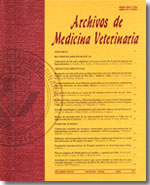Reproductive control in beef cows through vaginal progesterone; effects of various factors on fertility
Main Article Content
Abstract
A treatment based on progesterone impregnated vaginal sponges has been used to control breeding in suckled beef cows under grazing conditions. However, fertility has not always been satisfactory. The objective of this trial was to determine whether fertility of treated cows was affected by the following factors: parity and duration of treatment (exp. 1), presence of signs of oestrus at the moment of timed AI and duration of postpartum in anoestrus cows (exp. 2), the time for double timed AI and reduction to a single timed AI (exp. 3). Spring-calved suckled Angus cows 30 to 90 days (d) postpartum, in good body condition, were used. Cows received 10 mg of oestradiol benzoate i.m. and a vaginal sponge containing 2 g of progesterone (ESP treatment). Exp. 1. Parity (primiparous, n=53 vs multiparous, n=83) and duration of ESP (8 d, n=72 vs 11 d, n=71) were evaluated. Timed artificial inseminations were carried out 48 and 72 hs after sponge removal (AI-T). Pregnancy rates at AI-T and accumulated after 30 days of AI (pregnancy rate at day 30 = pregnancy at AI-T and at return to oestrus) were determined. Both factors did not interact (p > 0.05). ESP duration had no effect on pregnancy rate at AI-T and at day 30: 38 vs 42% and 56 vs 61%, 8 vs 11 d respectively (p > 0.05). Multiparous cows tended to present higher pregnancy rates at AI-t and at day 30: 39 vs 23% and 46 vs 28% (p < 0.1) multiparous vs primiparous respectively. Exp. 2. Anoestrus multiparous cows (n=124) were treated with ESP during 11 d. Procedures were similar to those in exp. 1. Oestrous rate was 24% and it appeared between 36 and 48 hours after treatment. Pregnancy rate at AI-t was 53 and 44% in oestrous cows and non oestrous cows (p > 0.05) while pregnancy rate at day 30 was 64 and 60% respectively. In those cows in which exact parturition date was available no different pregnancy rate at AI-t was found when cows were treated between postpartum days 30 to 59 (n=15), 60 to 89 (n=28) or 90 to 145 (n=20): 57, 55.3 and 52.6% respectively (p > 0.05). Exp. 3. Multiparous cows were treated with ESP during 11 d. The time for double AI-T had no effect on pregnancy rate: 38% when inseminated either at 48 and 72 hs (n=42) or 40 and 64 hs (n=47). The amount of AI-T did not affect the pregnancy rate: 22% with AI-T at 48 and 72 hs (n=46) vs 29% with one AI-T at 56 hs (n=48) (p > 0.05). In no case was pregnancy rate at day 30 affected. It is concluded that in ESP-treated postpartum beef cows, fertility tends to be lower in primiparous than multiparous cows. However, fertility is not affected by reduction of treatment duration from 11 to 8 d, presence of signs of oestrus in induced cows at timed AI, duration of postpartum anoestrus, displacement of double timed AI in 8 hours or reduction from double to single timed AI.

